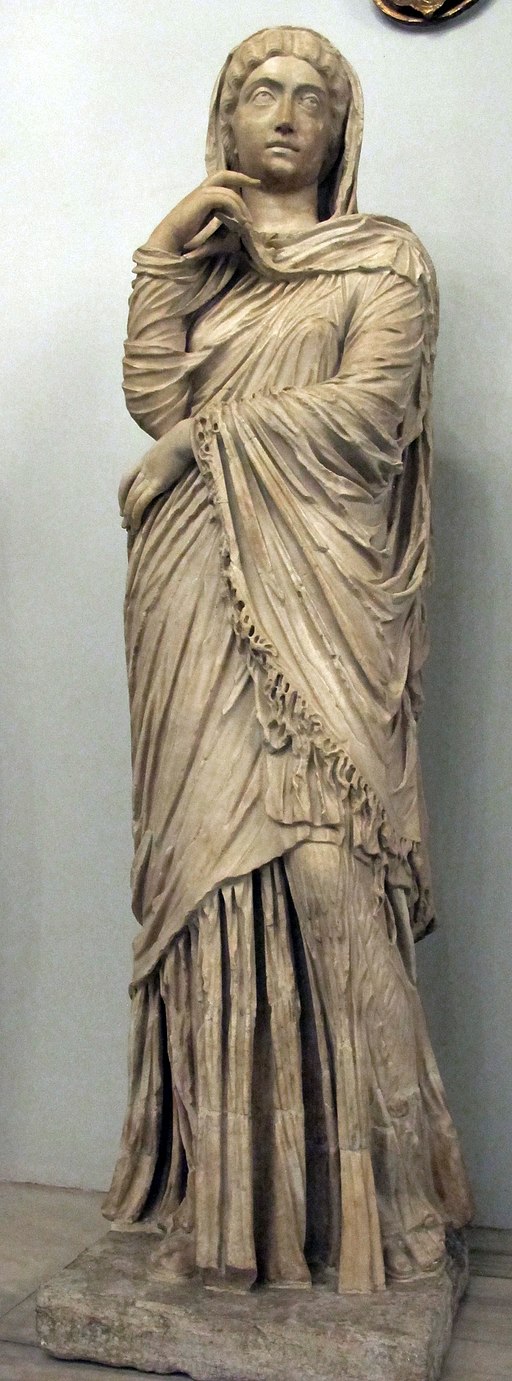
This statue of Roman Empress posing as Pudicitia is a Roman copy from the 2nd century AD based on an antique original from the 4th century BC.
“Pudicitia,” meaning “modesty,” was a central concept in ancient Roman sexual ethics. The virtue was personified by the Roman goddess Pudicitia, whose Greek equivalent was Aidos.
This statue was excavated in 1887 from the front of the Caracalla arch of the ancient city of Thasos. It is believed to represent the Empress Vibia Sabina, dressed as “Pudicitia.”
There are several famous statues of various women posing as Pudicitia in Italian museums that have influenced many European artists. “The Holy Women at the Sepulchre” by Peter Paul Rubens shows the influence of such Pudicitia statues.
Pudicitia
Pudicitia or “sexual virtue” is a word that is derived from the more general “pudor,” the sense of shame that regulated behavior as socially acceptable. Pudicitia was most often a defining characteristic of women.
Men who failed to conform to masculine sexual norms were said to exhibit feminizing “impudicitia,” or sexual shamelessness.
Pudicitia-type statue – Capitoline Museums, Rome
Empress Vibia Sabina
Vibia Sabina (83 – 137) was a Roman Empress, wife to Roman Emperor Hadrian. Sabina accumulated more public honors in Rome and the provinces than any imperial woman had enjoyed since the first empress, Augustus’ wife, Livia.
Sabina is the first woman whose image features on a series of coins minted in Rome. She was the most traveled and visible empress to date.
Her husband was thought to be more sexually interested in his favorite Antinous and other male lovers, and he and Sabina had no children. In 128, she was awarded the title of Augusta.

Pudicitia statue – Vatican Museum
Thassos
Thassos, where this sculpture was discovered, is a Greek island in the North Aegean Sea. The island was colonized at an early date by Phoenicians, then around 650 BC by Greeks, who founded a colony on Thasos.
During the war between Macedonia and the Romans, Thasos received its freedom at the hands of the Romans, and it was a “free” state for a while.
Thasos was part of the Eastern Roman Empire and then the Byzantine Empire for most of the Middle Ages.
Thasos was captured by the Genoese in 1434, who surrendered it to the Ottoman Empire in 1455.
In 1912 during the First Balkan War, the Greek navy freed Thasos from the Ottomans, and it became part of Greece.
Statue of Roman Empress posing as Pudicitia
- Title: Statue of Roman Empress posing as Pudicitia
- Year: 2nd century AD copy of 4th century BC original
- Material: Stone
- Discovered: 1887
- Find Site: Caracalla arch of the ancient city of Thasos
- Museum: Istanbul Archaeology Museum, Istanbul, Turkey
A Tour of the Istanbul Archaeology Museums
- Alexander Sarcophagus
- Tabnit Sarcophagus
- Siloam Inscription
- Statue of Roman Empress posing as Pudicitia
A Tour of Middle East Museums
- Arab Republic of Egyptian Museums
- Cairo Museums
- Egyptian Museum
- Cairo Museums
- Turkey Museums
- Istanbul Museums
- İstanbul Archaeology Museums
- Topkapı Palace
- Istanbul Museums
- Iran Museums
- Tehran Museums
- Reza Abbasi Museum
- Tehran Museums
- United Arab Emirates Museums
- Dubai Museums
- Dubai Museum
- Saeed Al Maktoum House
- Sharjah Museums
- Sharjah Museum of Islamic Civilization
- Dubai Museums
- Israel Museums
- The Israel Museum, Jerusalem
The white lie we’ve been told about Roman Statues
The Art of Ancient Rome – Sculpture and Reliefs
~~~
“Every new beginning comes from some other beginning’s end.”
– Marcus Annaeus Seneca
~~~
Photo Credits: 1) G.dallortoG.dallorto / Attribution via Wikimedia Commons; Sailko / CC BY creativecommons. ; Giacomo Brogi / Public domain
Popular this Week








 Sponsor your Favorite Page
Sponsor your Favorite Page SEARCH Search for: Search Follow UsJoin – The JOM Membership Program
Sponsor a Masterpiece with YOUR NAME CHOICE for $5
Share this:
- Tweet

